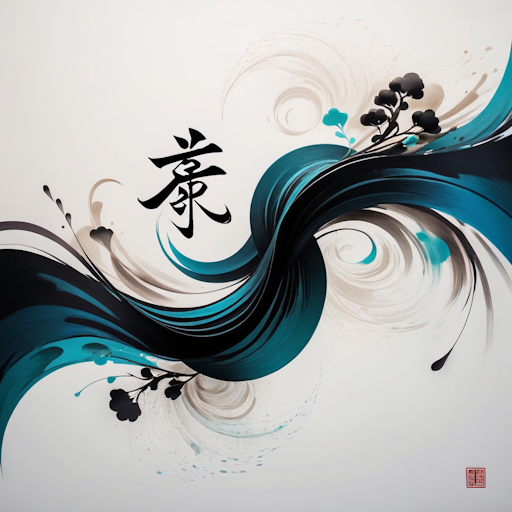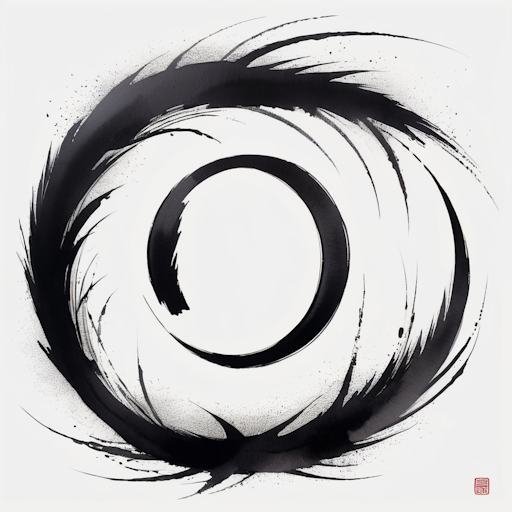In the vast realm of artistic expression, Zen calligraphy stands as a serene testament to the seamless fusion of spirituality and brushwork. Originating during the Tang Dynasty in China and later evolving in Japan under the influence of Zen Buddhism, this art form transcends the mere strokes on paper, embodying mindfulness and the profound beauty of simplicity. This article unfolds the historical tapestry, explores the nuanced techniques, delves into the philosophical underpinnings, and guides you on the initiation into the captivating world of Zen calligraphy.
The History of Zen Calligraphy
The roots of Zen calligraphy delve deep into the soil of both Chinese and Japanese artistic traditions. Initially known as “Chan painting” during China’s Tang Dynasty, reflecting the Chinese term for Zen, this art form later found its way to Japan, where it flourished and evolved under the influence of Zen Buddhism. It serves as a visual expression capturing the fleeting moments of enlightenment experienced by Zen practitioners.
Techniques and Brushwork in Zen Calligraphy
At the heart of Zen calligraphy lies a deceptive simplicity that emerges from the intricate dance of brush, ink, and paper. These elements become extensions of the artist’s spirit, moving in unison to create an expression of the present moment.
Zen calligraphy techniques prioritize spontaneity and directness. The artist seeks to transcend conscious thought, enabling the brush to move freely and capture the essence of the subject. Each stroke becomes a form of meditation, a mindful act reflecting the artist’s state of being.

Transition words seamlessly guide the brush, linking one stroke to the next. The rhythm of the artist’s breath intertwines with the dance of the brush, creating a harmonious flow of energy onto the canvas. This dynamic interaction is not merely a visual representation but a spiritual journey, transforming the act of creation into a meditative experience.
How to Get Started with Zen Calligraphy
Embarking on a Zen calligraphy journey necessitates an open mind and a willingness to be present in the moment. Here are essential steps to guide you in your initiation into this profound art form:
- Gather Your Materials:
- Acquire quality brushes, ink, and absorbent paper.
- Create a serene and uncluttered space dedicated to your practice.
- Understand Basic Strokes:
- Familiarize yourself with fundamental brushstrokes, including horizontal, vertical, and diagonal lines.
- Practice these strokes to develop control and fluidity.
- Study Masterpieces:
- Explore the works of renowned Zen calligraphers.
- Analyze their techniques and attempt to replicate certain aspects.
- Embrace Mindfulness:
- Approach each stroke with a focused and clear mind.
- Allow yourself to be fully present in the act of creation.
Transitioning from one stroke to another, each movement becomes a meditation in motion. The brush becomes an extension of the artist’s essence, capturing the flow of energy in each carefully crafted mark.
The Beauty of Imperfection in Zen Calligraphy
Zen calligraphy is more than an artistic endeavor; it’s a journey into the heart of mindfulness and simplicity. The historical tapestry unfolds stories of spiritual evolution, while the techniques and brushwork reveal the profound beauty inherent in the act of creation.
As you embark on your Zen calligraphy journey, remember that perfection is not the goal; it’s about embracing imperfections and nuances in each stroke. The canvas becomes a mirror reflecting your state of mind and the depth of your being.
Navigating the Depths of Zen Calligraphy
To truly appreciate the essence of Zen calligraphy, one must delve into the depths of its philosophy. The art form encapsulates the Zen concept of “Enso,” a symbol of enlightenment, strength, and the impermanence of existence. The simple yet profound act of creating a circle with a single brushstroke embodies the interconnectedness of all things and the eternal cycle of life.

Transitioning from theory to practice, one must embrace the concept of “Shoshin,” or “beginner’s mind.” This fundamental principle encourages a mindset free from preconceptions. Allowing the artist to approach each stroke with fresh eyes and an open heart. In the world of Zen calligraphy, every stroke is an opportunity for discovery, a manifestation of the ever-changing present.
Embracing Zen Calligraphy as a Lifestyle
Beyond the confines of artistic practice. Zen calligraphy has the potential to permeate various aspects of life, becoming a mindful and transformative lifestyle. The principles of simplicity, mindfulness. Embracing imperfection extend beyond the canvas, influencing daily routines and fostering a deep sense of presence.
Transitioning from the meditative space of calligraphy practice to the chaotic rhythm of daily life may initially seem challenging. However, the essence of Zen calligraphy lies in its ability to foster a seamless integration of mindfulness into every moment.
Conclusion
In the gentle strokes of the brush and the ink that flows like a river. Zen calligraphy emerges as more than an art form. It becomes a doorway to mindfulness, spirituality, and the celebration of imperfection. As you embark on your journey into the world of Zen calligraphy remember the canvas is not just a surface for strokes. But a mirror reflecting the depth of your being.
With the historical roots, techniques, philosophical underpinnings, and the potential for a transformative lifestyle explored. You are equipped to embrace Zen calligraphy not only as an artistic pursuit but as a holistic approach to life. As the brush meets the canvas, may each stroke be a celebration of the present moment, a meditation in motion, and a testament to the beauty found in the dance of brush and ink.